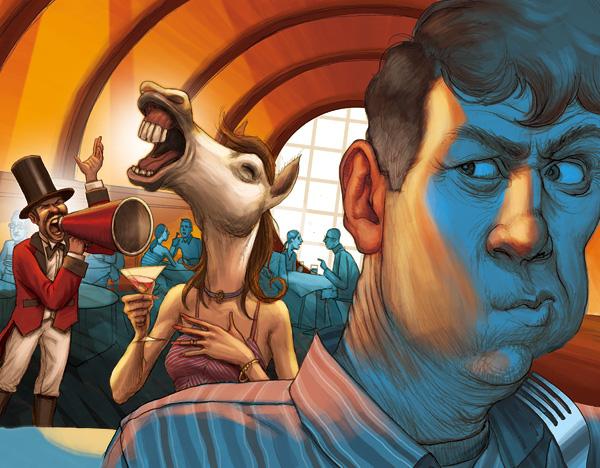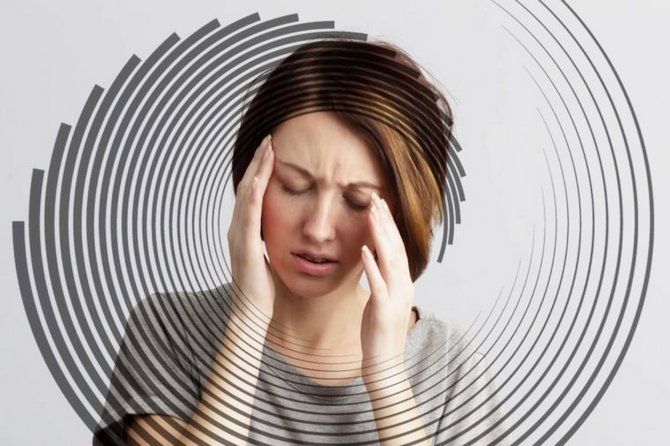How to determine clouding of consciousness?
This state is characterized by detachment from the world.
It is difficult for patients to comprehend reality. They are poorly oriented in time, space and are not aware of the situation. Also, thinking becomes fuzzy. The patient cannot establish a connection between events. At the moment when there is stupefaction, the patient does not remember events. According to the groups of disorders, a decrease in the level of consciousness is distinguished, in which there is inhibition or lack of contact with the patient. There are many intermediate states between a clear mind and coma. Stupefaction is a psychosis that is accompanied by hallucinations, delusions and agitation. Reality has been replaced by a fictional world.
An altered state of consciousness is the concentration of attention on some object. At the same time, the patient is fenced off from other phenomena of reality.
Beginning and signs of mental confusion
The beginning of darkening of the mind (when a sign of it begins to reveal itself in the soul) is first of all seen in laziness towards God’s service and prayer. For, if the soul does not first fall away from this, there is no other way to spiritual deception; when it is deprived of God's help, it conveniently falls into the hands of its opponents. And also, as soon as the soul becomes careless about deeds of virtue, it will certainly be carried away into the opposite. For the transition from any side is already the beginning of the opposite side. Doing good is caring for the spiritual, and not for the vain. Continually reveal your weakness before God and you will not be tempted by strangers, as soon as you are left alone without your Intercessor.
(Word 2, p. 12)
Thoughts
When a certain evil thought is sown in you, either from among those coming from afar, or from among those pre-occupied (previous impressions) by you, it first and often appears in your mind, then recognize it as true that it is hiding a net for you. But you wake up and become sober in time. And if the thought is from the right side and good, then know that God wants to give you a certain way of life, and therefore this thought, beyond the usual, is aroused in you. If your thought is darkened and you doubt it and cannot clearly comprehend whether it is your own or a thief, a helper or a slanderer hiding under a good guise, then arm yourself with diligent and immediate prayer against it with much vigil, day and night. Don’t tear him away from you and don’t agree with him; but with diligence and fervor, make a prayer for him and do not be silent, calling on the Lord. He will show you where this thought comes from.
(Word 40, p. 170)
Reasons for their appearance
The movement of thoughts in a person occurs for four reasons: firstly, from natural carnal lust; secondly, from the sensory representation of worldly objects, which a person hears about and which he sees; thirdly, from pre-occupied concepts (previous impressions) and from the spiritual inclinations that a person has in his mind; fourthly, from the attack of demons who fight with us, involving us in all passions, for the reasons mentioned above. Therefore, a person, even before death, while he is in the life of this flesh, cannot help but have thoughts and battles. For, judge for yourself, is it possible that before a person’s departure from the world, and before death, any one of these four causes should become inactive? Or is it possible for the body not to covet necessities and not be forced to desire anything worldly? If it is inappropriate to imagine something like this, because nature has a need for such things, then it already means that passions act in everyone who wears a body, whether he wants it or not. Therefore, every person, as someone who carries a body, must protect himself not from one passion, which is clearly and incessantly active in him, and not from two, but from many passions. Those who have conquered the passions within themselves through virtues, although they are disturbed by thoughts and the attack of these four causes, nevertheless do not yield to victory over themselves, because they have strength and their mind is delighted with good and Divine remembrances.
(Word 4, pp. 23-24)
Clouding of consciousness: types
The most common syndromes are amentia, delirium, twilight stupor and oneiroid.
Often such phenomena are observed against the background of intoxication or mental illness. Delirium is an acute psychosis in which there is noticeably pronounced agitation, disorientation in time and place, hallucinations and colorful illusions. In this state, the assessment of one’s personality is preserved.
Amentia is more common with malnutrition. The patient does not make contact. He sometimes has hallucinations or illusions. Thinking is incoherent.
Twilight darkness is characterized by the fact that patients can perceive only individual fragments of reality. Moreover, the reaction to these circumstances is extremely unexpected. Patients usually show aggression and anger. Contact is almost impossible. Patients may perform automatic actions, such as putting on clothes. When the psychosis passes, the patient does not remember what he did.

Oneiric obscuration is a fragmented perception of reality combined with vivid hallucinations. Patients seem to see their lives from the outside. Visions come from lived events, watched films and read books. A dual orientation is possible, i.e. the patient may be aware that he is in a hospital, but at the same time believe that he is participating in some fantastic events.
Even a healthy person may have a state of altered consciousness. For example, if you concentrate on the doctor’s words, you can stop perceiving the world around you. It is in this way that clouding of consciousness is achieved during hypnosis.
If hysterical attacks occur, then after psychosis the person remembers only part of the events. But under the influence of hypnosis, you can restore the memory of what happened.
In any case, a psychiatrist deals with the treatment of all these conditions. It is important to conduct a timely examination, make a diagnosis and begin the appropriate procedures.
Medical educational literature
Consciousness as a person’s ability to adequately reflect the surrounding reality and purposefully influence it is always impaired in mental illness. In most of these cases, we are talking about a violation of the reflection of the surrounding reality in terms of only the most complex relationships between objects and phenomena, i.e. at the level of rational cognition, while the reflection of these objects themselves in their simplest connections and relationships, i.e. sensory cognition is not suffers.
Clouding of consciousness is that special case of its disorder in which the reflection of both the most complex relationships between objects of the surrounding world and these objects and phenomena themselves suffers, i.e., there is a simultaneous violation of rational and sensory cognition. Clinically, this is manifested by gross irregularity in the patient’s behavior, due not only to the fact that he does not understand the meaning of the events taking place and does not remember them, but also does not grasp the immediate reality of the surrounding world.
There are a number of signs of confusion that are common to all its clinical varieties:
- disorientation in place, time and surroundings;
- detachment from the surrounding world, manifested in incomplete coverage of it, in a unclear perception of the real world, in fragmentation, or in the complete impossibility of its perception;
- incoherent thinking, weak judgment;
- amnesia for the period of stupefaction.
To establish the fact of stupefaction, it is necessary to establish all these four signs, and not one or two of them. Thus, disorientation can be observed in senile psychosis, amnesia in Korsakov’s psychosis, weakness of judgment in dementia, but in none of the mentioned psychoses there is clouding of consciousness. It is not enough to differentiate various syndromes of clouding of consciousness from each other only by the depth and severity of clouding of consciousness, since each syndrome (for example, delirium) can vary widely in the severity of its main criteria, in particular the severity of exclusion from the situation. At the same time, it is necessary to subdivide the forms of clouding of consciousness (regardless of the depth of its darkening) into various types, highlighting the quality of clouding of consciousness in their structure (hallucinatory, confused, pathologically narrowed, etc.). It is the latter that makes it possible to subdivide the forms of darkened consciousness into their various types.
The state of stupefaction is characterized by a more or less sharp increase in the lower thresholds of sensations and perceptions, due to which patients appear difficult to reach, detached from the environment. They are inactive, their movements are slow, their facial expression is dull and indifferent. Of the surrounding influences, not all stimuli are perceived and cause a reaction. Weak and even moderate strength (optimal, “ordinary”) stimuli do not reach consciousness and are not perceived by patients. Only stimuli of sufficiently strong strength are perceived and give a weakened and delayed reaction. In this regard, the perception of surrounding objects is carried out incompletely, with difficulty, ideas turn out to be pale, dull, and emotionally weakly colored. The associative process is sharply slowed down, the connection of ideas and ideas is extremely difficult, the patient does not grasp the entire situation. He gives the impression of being drugged by something; there is more or less pronounced disorientation. Mental contact with the patient is especially difficult. He does not understand complex questions, he perceives simple ones with difficulty after repeating them repeatedly in a loud voice, as if overcoming a difficult obstacle, and often does not finish his thoughts. Reproduction of the past is sharply weakened, the new is not remembered. A characteristic feature of states of stupor, along with this, is the absence of delirium, hallucinations, distractibility and other productive symptoms, i.e. emptiness of consciousness. The mildest degrees of stupefaction, manifested by mild and unstable fogging of consciousness, are called nullification.
As the state of stupor deepens, it turns into stupor. At the same time, the patient is in a state of deep stupefaction, he does not respond to speech addressed to him or to other stimuli; outwardly gives the impression of a person in a state of unusually deep sleep. With strong, extreme influences, the patient can be brought out of this state for a short time: he opens his eyes, looks around, but does not understand the events taking place, does not “embrace” the situation, is disoriented and immediately falls back into the previous soporotic state. The emptiness of consciousness is even greater than with stupor; patients are completely indifferent and aspontaneous. Simpler instinctive reactions, in particular defensive ones, are also suppressed. Tendon and oculoprotective reflexes and withdrawal of the hand during an injection, although preserved, are sharply weakened and slowed down, which indicates a more massive unconditioned inhibition, extending during stupor to the subcortical and brainstem-diencephalic structures.
Coma is the most severe degree of clouding of consciousness of this quality, i.e., virtually complete shutdown of consciousness. Patients in this state are motionless, their eyes are closed, they do not make any movements, do not show any activity. As with the two previous syndromes, there are no delusions, hallucinations, or other productive symptoms. Patients do not respond to speech, or to loud and repeated calls, or to intense sound, visual and other influences; It is absolutely impossible to stir them up. Unconditional reflex subcortical activity is also sharply suppressed: tendon reflexes, withdrawal of the hand when pricked with a needle, and even the phylogenetically most ancient protective reflex of closing the eyelids when an object approaches the eye are completely absent. The activity of only vital centers - respiratory and vasomotor - is preserved. However, if events develop unfavorably, their functioning is disrupted and the patient may die without leaving a coma. Coma, thus, is the heaviest, deepest clouding of consciousness, its shutdown. The state of stupor is observed in infectious, traumatic and organic lesions of the central nervous system; in case of intoxication, poisoning with various substances (in particular barbiturates) and can last from a few seconds to many days.
Twilight stupefaction, along with disorientation of patients in the environment and their exclusion from the situation, is usually characterized by strong affects of rage, anger and fear, the presence of fragmentary sensory delirium and individual hallucinations, as well as the ability of patients to perform a series of sequential automated actions. The latter circumstance sometimes gives the patient’s relatives and those around him the impression of external preservation of his mind and gives this type of clouding of consciousness a very special flavor. The perception of such patients is defective: they perceive some objects and objects as such, others - pervertedly, and therefore do not recognize friends and relatives.
The field of consciousness is pathologically narrowed with fixation only on a narrow range of ideas or pervertedly perceived real objects. In such patients, there is either a series of automated actions with an external pathological fixation of their attention on something incomprehensible, or motor agitation, which, in combination with hallucinations, affects of anger, fear and fragmentary delusional ideas, makes them extremely dangerous to others.
There are a number of variants of twilight states, among which the most important are delusional and brutal. In the first case, patients, being disoriented and tense, give an external impression of being internally extremely focused, not taking into account the situation and capable of consistent automated actions. Sometimes in this state they move within a populated area, “drive” around the city, coming to their senses from time to time, that is, briefly gaining orientation, then again falling into a state of darkened consciousness. Driven by delusional ideas and emotions, they sometimes commit serious offenses with complete amnesia of everything that happened, treating (after emerging from the twilight state) their actions as something alien and unfamiliar.
In other cases, the duration of this state is shorter, but the patients turn out to be more excited and, possessed by the strongest affects of anxiety, anger and fear, experiencing visual hallucinations, “snippets” of delirium, show severe blind aggression, crushing everything in their path, indiscriminately maiming and killing loved ones and strangers. This version of the twilight state usually occurs continuously, but lasts much less and also ends in sleep (sometimes right there, near the victim) followed by amnesia.
States of ambulatory automatism are twilight states that occur without delusions, hallucinations and emotional disorders. In such cases, the patient, busy with some activity or on the road, continues this activity, but in the form of a consistent series of automated movements and actions, already showing twilight stupefaction. The environment no longer completely covers, although it gives answers to simple questions and gives the impression of an extremely focused person to an outside observer. Upon exiting this state, amnesia is detected; the patient does not understand how he got here.
Fugue is a peculiar version of outpatient automatism, when the patient suddenly suddenly rushes forward, runs, having lost orientation and assessment of the surroundings. Sometimes it starts spinning in place or running around in a curve. The condition is short-lived, lasts 2-3 minutes, and after it passes, the patient does not remember everything that happened.
Somnambulism is a state of ambulatory automatism that occurs during sleep.
Absence (absence) is a complete shutdown of consciousness for a split second. At the same time, the patient’s thoughts and speech are interrupted, he becomes silent, and objects fall out of his hands. Having come to his senses, the patient does not immediately gather his courage and gain self-confidence.
All types of twilight stupefaction are usually characterized by short duration and paroxysmal nature: sudden onset and rapid reduction. They are observed in toxic, traumatic, vascular and organic diseases of the brain and with particular frequency and severity in epilepsy.
If you find an error, please select a piece of text and press Ctrl+Enter.
Quantitative disorders of consciousness

Quantitative disorders include syndromes of switching off consciousness:
- nullification,
- stunning,
- doubtfulness,
- sopor,
- coma.
They differ from each other in the depth of clinical manifestations. In some conditions (traumatic brain injury, intracerebral hemorrhage, etc.), disorders can successively replace each other.
Nullification is the least severe violation. Psychiatrists call it “cloudy” consciousness. The main symptoms include general absent-mindedness, inability to focus on any activity, and errors when answering simple questions. The mood is labile and inadequate to the surrounding environment. Nubilization lasts several minutes, but can last several hours if it develops against the background of malignant formations in the structures of the central nervous system or severe intoxication.
Stunning is the second most profound disturbance of consciousness. The patient's threshold of excitability for any stimuli increases. Patients perceive speech addressed to them poorly and understand only simple sentences. The speed of thinking is slowed down. The answers use few words. Motor activity is also suppressed, and movements are made with errors. Memory also suffers - patients have difficulty remembering and reproducing information. An important difference from qualitative disorders is associated with the absence of productive symptoms: delusions, hallucinations, etc. After emerging from stunning, the sufferer does not remember the period of the disorder.
Doubtfulness is similar to drowsiness, in which a person does not open his eyes for a long time. The patient quickly and correctly answers simple questions. However, complex issues are ignored due to impaired comprehension. With a strong external influence (scream, bright light), the symptoms of somnolence and stupor temporarily disappear.
Stupor - when it develops, the patient is completely immobilized. There is no facial expression, and the eyes are closed. Verbal contact is impossible. When exposed to strong stimuli, in contrast to doubtfulness, stereotypical speech and motor reactions occur. The latter are protective in nature.
Coma is the most severe quantitative disorder of consciousness. Occurs with severe intoxication with alcohol, drugs, organic lesions of the central nervous system and metabolic disorders. Consciousness, as well as reaction to external stimuli, is completely absent.
Therapy for quantitative disorders of consciousness is based on eliminating the underlying causes. For this purpose, an examination is carried out for organic brain pathology or intoxication.



